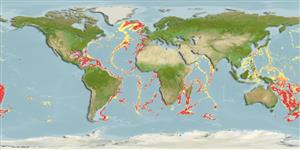>
Ophidiiformes (Cusk eels) >
Bythitidae (Livebearing brotulas)
Etymology: Aphyonus: Greek, aphyes = sardine + Greek, onos = hake.
More on author: Günther.
Environment: milieu / climate zone / depth range / distribution range
Ökologie
seewasser bathydemersal; tiefenbereich 625 - 2560 m (Ref. 105129). Deep-water
Indo-West Pacific: from off East Africa eastwards to Japan and New Zealand and in the Atlantic Ocean.
Size / Gewicht / Alter
Maturity: Lm ? range ? - ? cm
Max length : 15.0 cm SL Männchen/unbestimmt; (Ref. 7408); 14.8 cm SL (female)
Rückenflossenweichstrahlen (insgesamt): 92-118; Afterflossenweichstrahlen: 61 - 78. This species is distinguished by the following characters: with joined vertical fins and loose, transparent, scaleless skin; body depth at origin of anal fin 13.0-16.5% SL; eyes are small or not externally visible; mouth almost horizontal; upper jaw ends well behind the eye; palatines edentate; jaws with small blunt or pointed teeth, no fangs; vomer with 3-7 fangs; anterior gill arch with 3-4 long rakers; D 92-118; A 61-78; pectoral fin 17-20 rays, with peduncle as long as or a little longer than high; pelvic fin with one ray; caudal fin rays 6-8; precaudal vertebrae 28-33, total vertebrae 77-87; vertebral centra in adults almost rectangular in lateral view; vertebrae generally poorly ossified; sagittal otolith rather large, oval and thin; penis partly covered ventrally by genital hood that ends in a medially placed clasper ventral to penis; no paired claspers in both sexes; fresh specimens with black peritoneum (Ref. 105129).
Found on or near bottom (Ref. 6527). The well-developed penis and reported presence of numerous spermatophores in histologically examined testes indicate internal fertilization. Eggs are found up 1 mm in diameter, but embryos were not observed (Ref. 105129). Uncommon species (Ref. 34024).
Life cycle and mating behavior
Geschlechtsreife | Fortpflanzung | Ablaichen | Eier | Fecundity | Larven
Nielsen, J.G., 2015. Revision of the aphyonid genus Aphyonus (Teleostei: Ophidiiformes) with a new genus and two new species. Zootaxa 4039(2):323-344. (Ref. 105129)
IUCN Rote Liste Status (Ref. 130435)
Bedrohung für Menschen
Harmless
Nutzung durch Menschen
Fischereien: nicht kommerziell
Mehr Information
ReferenzenAquakulturAquakultur ProfilZuchtlinienGenetikElectrophoresesVererbbarkeitKrankheitenVerarbeitungNutrientsMass conversion
PartnerBilderStamps, Coins Misc.LauteCiguateraGeschwindigkeitSchwimmstilKiemenoberflächeOtolithsGehirngrößeSehfähigkeit
Tools
Zusatzinformationen
Download XML
Internet Quellen
Estimates based on models
Preferred temperature (Ref.
123201): 2.4 - 5.8, mean 3.9 °C (based on 957 cells).
Phylogenetic diversity index (Ref.
82804): PD
50 = 0.5625 [Uniqueness, from 0.5 = low to 2.0 = high].
Bayesian length-weight: a=0.00457 (0.00179 - 0.01169), b=3.10 (2.87 - 3.33), in cm total length, based on LWR estimates for this (Sub)family-body shape (Ref.
93245).
Trophic level (Ref.
69278): 3.4 ±0.5 se; based on size and trophs of closest relatives
Widerstandsfähigkeit (Ref.
120179): hoch, Verdopplung der Population dauert weniger als 15 Monate. (Preliminary K or Fecundity.).
Fishing Vulnerability (Ref.
59153): Low vulnerability (10 of 100).
